The Ferdinand 88mm Tank Destroyer
The first version of this WW2 German heavy Tank Destroyer was called the Ferdinand, after its designer Ferdinand Porsche, and then later the upgraded version with a hull mounted machine gun was given the name the Elefant (Elephant).
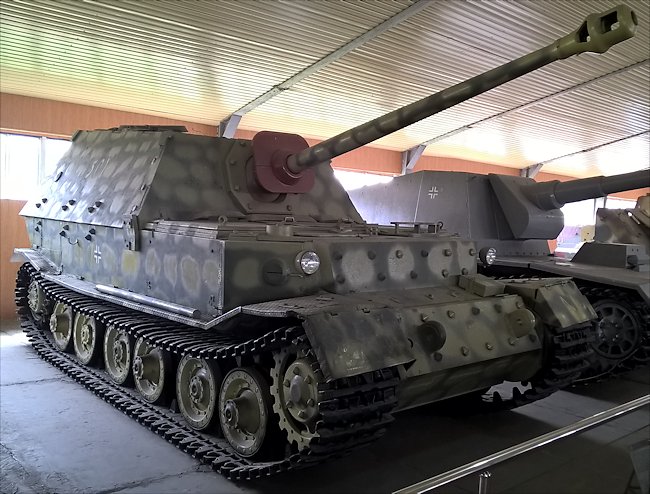
Preserved German Ferdinand Tank Destroyer at the Russian Kubinka Tank Museum. The side storage box is missing.
Location
Take the train from Moscow's Belorusskaya Railway Station, in the north west of the city, to Kubinka. It is about an hours train journey. It is a direct service, no need to change, and the the tickets are cheap. Make sure you print off a list of station names so you can check off where you are and get ready to get off the train at Kubinka. The station names are not always easy to read or see.
Although this military town has been active for over 80 years it has a rundown look to it. You can walk to the museum but there is the equivalent of a motorway crossing your route. There are no pedestrian crossings over it. There are a number of taxi stands near the station. They are very cheap and honest. I tried to give the driver a big tip but he refused. Ask for his card so you can ask the Museum gate staff to call his company when you are finished at the Museum to get back to the railway station.
Development
There are only Two left in the whole world of the 90 that were built by the Germans in WW2. One is in the Kubinka Tank Museum just outside Moscow, Russia and the other in the US Army Ordnance Museum in America. Its official name was Schwerer Panzerjager Tiger (P) Sd.Kfz. 184 Tank Destroyer (Schwerer = Heavy and Panzerjager = tank hunter). It weighed 71 metric tons fully combat loaded with fuel ammo and equipment. It weighed 65 tons unloaded.
It had a devastating 88mm Pak 43/2 anti-tank gun that could penetrate the armour of most Soviet and Allied tanks in World War Two. It was an improvement over the original 88mm anti-aircraft gun that had been used so effectively in the Battle for France and in the North African Desert Campaign, to knock out allied tanks. It was supposed to be one of Hitler's wonder weapons that could destroy Soviet tanks at long range. Most Russian tanks could be knocked out at a distance of 2,000 metres
The Elefant Tank Destroyer in America saw action on two fronts. First on the Russian Front during the greatest tank battle of all time: the battle of Kursk. Later at Anzio in Italy trying to stop the advancing American and Commonwealth troops where it was captured.
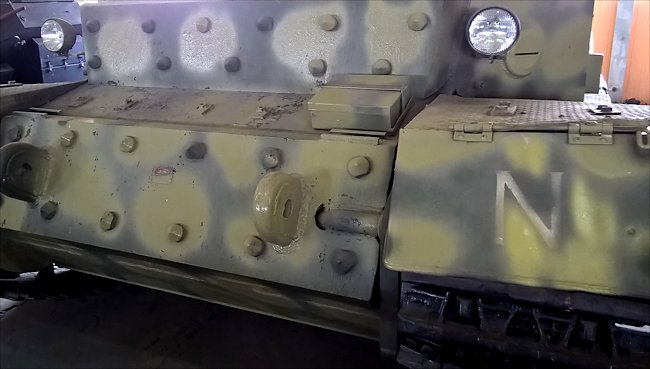
Front hull view of the Ferdinand Tank Destroyer. There is no machine gun or drivers slit in the front bolted on thick armour plates.
It was not designed from the outset as a heavy tank destroyer. The German's had tried to develop an new heavy tank and had two competing designs for this contract. One of the designs was put forward by automotive engineer Ferdinand Porsche who would later become very famous for his range of sports cars.
Porsche's design did not win but he had already manufactured some 91 chassis in the Nibelungenwerk factory in Sankt Valentin, Austria. In the middle of a world war on multiple fronts these tank chassis were too precious to waste. He suggested that you could put an 88mm gun onto the Chassis and make them into a gigantic tank destroyer. This option was taken up by the German High Command.
In honour of this new tank destroyer's designer it was given the name Ferdinand. On paper she looked very powerful but had not been tested in battle conditions. It was found that there were many crippling design flaws. At the Battle of Kursk July 1943, the Germans would learn that their brand new super weapon was little more than a sitting duck.
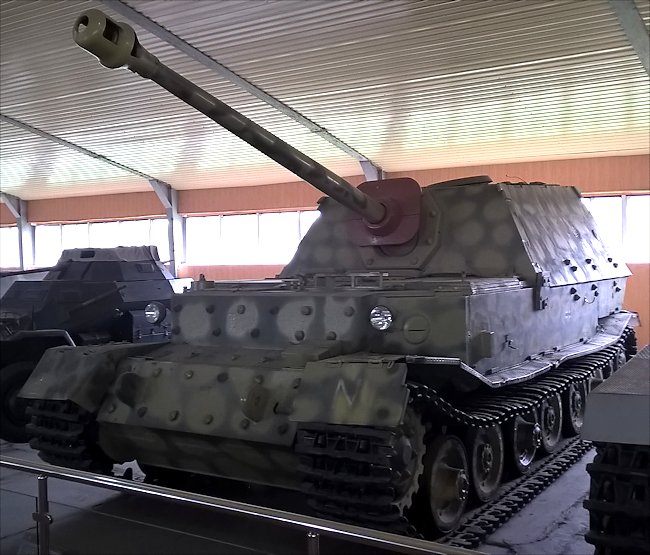
The German Ferdinand Tank Destroyer driver had two side vision slits and a cupola above the frontal 200mm armour
Russian tank designers and production facilities could not match the German advance complicated tank design features. Their answer was to produce good tanks like the T34 in over whelming quantity rather than extremely high quality tanks in limited numbers like the Germans.
The Russian T34 tank was nowhere near as good as the German Panther and Tiger tanks in terms of armour and main gun, but on the other hand there were swarms of the T34 tanks for each German tank to deal with. This made all the difference between victory and defeat in World War Two.
Although the Elefant and Ferdinand rolls on tracks and has a large gun it is technically a Tank Destroyer as it does not have a turret. It was used as a self-propelled anti-tank gun or an assault gun. It required a crew of six: Commander, driver, radio-operator, gunner and two loaders.
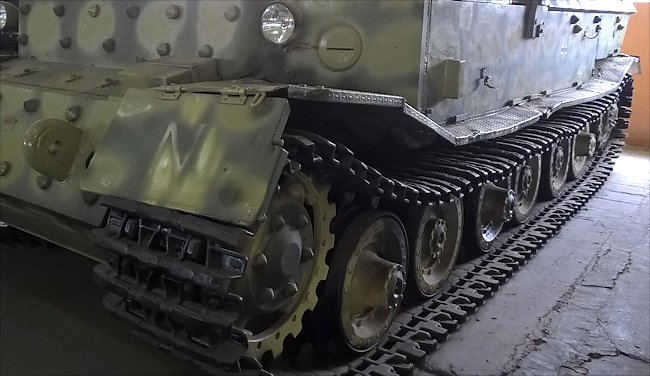
Side view of a Ferdinand Tank Destroyer's Porsche designed tank chassis"
It had great armour protection and an excellent gun but the weight of the vehicle meant that It was slow. Additional 100mm bolt on armour plates on the front of this tank destroyer increased the crews protection to 200mm thickness but added an additional 5 tons of weight. Side and rear armour thickness was 80mm. It only had a top speed of 30km per hour (19 mph). It could not move around the battlefield as fast as the crew needed it to go.
Each side of the Elefant has six large road wheels, one idler and one track drive wheel. Each road wheel weighs about 113 kilos and was very difficult to change on the battle field without additional equipment. This resulted in some vehicles having to be abandoned.
A very serious design flaw was the lack of a machinegun for close protection against advancing infantry. It was overlooked because the vehicle was meant to operate behind the front line and take out enemy units at over 2km distance and not come in contact with enemy soldiers. The reality of a mobile battlefield meant that courageous brave soviet troops could run forward and attach a sticky mine or throw on a Molotov cocktail without fear of being machine gunned by the tank destroyer crew.
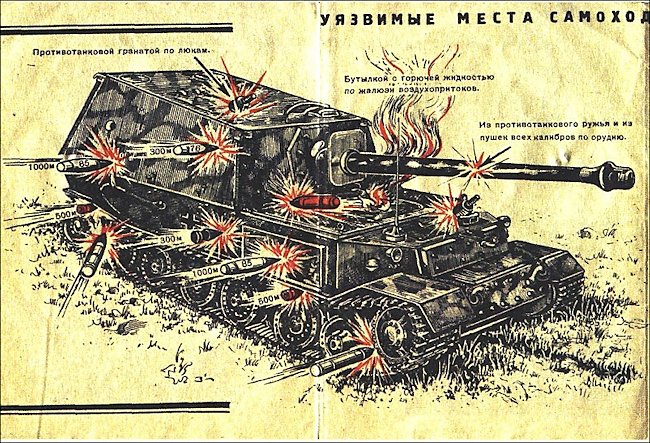
Red Army instruction book on how to kill a German Ferdinand Tank Destroyer showing its weak spots and the distance from target Russian tank crews need to be before their shell had a chance of penetrating the armour.
Another problem with this type of combat vehicle is that the gun has a limited travers. As it does not have a turret the whole vehicle has to move to aim at a new target to its side. If an enemy tank is coming straight for your position that is no problem but because the Russian T34 tanks were very mobile they would try to out flank the Ferdinand and attack its rear or side. The tank crew had to traverse the entire vehicle to in an effort and track the threat. This was extremely difficult to do against multipole fast moving targets.
The majority of the Ferdinand tank destroyer losses on the battlefield of Kursk were not from combat. The majority had to be abandoned by their crews because of mechanical breakdown or damage to its wheels and tracks from mines. Because it was so heavy it required five Bergepanzer IV tank recovery vehicles linked in tandem to pull a disabled Ferdinand off the frontline. This was okay when the German Army was on the offensive as the engineer teams could work in the relative safety of night fall to recover the damaged and broken down vehicles. It was nearly impossible when the enemy were on the offensive.
The flawed Ferdinands that survived the defeat at Kursk were put on the back of railway flat carriages. Records show that 48 were in a suitable condition to receive upgrades. They were sent to engineering workshops of the Nibelungenwerk factory in Austria in November 1943 to be retro fitted with a ball-mounted MG 34 machinegun in the front hull before being redeployed.
They were also fitted with protective grills over the engine to make give them better protection from Molotov Cocktails. A commander's cupola was added to the top of the hull. Zimmerit was pasted over the outer body as a protection from magnetic limpet mines. The frontal armour was thickened and the tracks widened adding an additional 5 tons in weight.
The Ferdinand fitted with these new upgrades was renamed the Elefant. The restored example in the Kubinka Tank Museum in Russia is an example of an Early Ferdinand. The preserved tank destroyer in America has all the upgrades and is an example of the Elefant version of this combat vehicle.
Where can I find other preserved Ferdinand and Elefant Tank Destoyers?
- Tank Museum in Kubinka, Russia (Ferdinand captured Battle of Kursk)
- US Army Ordnance Museum, Fort Lee, VA, USA (Elefant captured Anzio, Italy)
- Source - Pierre-Oliver Buan - http://the.shadock.free.fr/Surviving_Panzers.html
WW2 tank books

